The Gondoliers
The Gondoliers; or, The King of Barataria is a Savoy Opera, with music by Arthur Sullivan and libretto by W. S. Gilbert. It premiered at the Savoy Theatre on 7 December 1889 and ran for a very successful 554 performances (at that time the fifth longest-running piece of musical theatre in history), closing on 30 June 1891. This was the twelfth comic opera collaboration of fourteen between Gilbert and Sullivan.
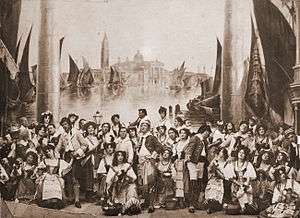
The story of the opera concerns the young bride of the heir to the throne of the fictional kingdom of Barataria who arrives in Venice to join her husband. It turns out, however, that he cannot be identified, since he was entrusted to the care of a drunken gondolier who mixed up the prince with his own son. To complicate matters, the King of Barataria has just been killed. The two young gondoliers must now jointly rule the kingdom until the nurse of the prince can be brought in to determine which of them is the rightful king. Moreover, when the young queen arrives to claim her husband, she finds that the two gondoliers have both recently married local girls. A last complicating factor is that she, herself, is in love with another man.
The Gondoliers was Gilbert and Sullivan's last great success. In this opera, Gilbert returns to the satire of class distinctions figuring in many of his earlier librettos. The libretto also reflects Gilbert's fascination with the "Stock Company Act", highlighting the absurd convergence of natural persons and legal entities, which plays an even larger part in the next opera, Utopia Limited. As in several of their earlier operas, by setting the work comfortably far away from England, Gilbert was emboldened to direct sharper criticism at the nobility and the institution of the monarchy itself.
Background
Genesis of the opera
The Gondoliers was preceded by the most serious of the Gilbert and Sullivan collaborations, The Yeomen of the Guard. On 9 January 1889, three months into that opera's fourteen-month run, Sullivan informed the librettist that he "wanted to do some dramatic work on a larger musical scale", that he "wished to get rid of the strongly marked rhythm, and rhymed couplets, and have words that would have a chance of developing musical effects."[1] Gilbert counselled strongly that the partnership should continue on its former course:
I have thought carefully over your letter, and while I quite understand and sympathize with your desire to write what, for want of a better term, I suppose we must call 'grand opera,' I cannot believe that it would succeed either at the Savoy or at Carte's new theatre.... Moreover, to speak from my own selfish point of view, such an opera would afford me no chance of doing what I best do — the librettist of a grand opera is always swamped in the composer. Anybody — Hersee, Farnie, Reece — can write a good libretto for such a purpose; personally, I should be lost in it. Again, the success of the Yeoman [sic] — which is a step in the direction of serious opera — has not been so convincing as to warrant us in assuming that the public want something more earnest still.[1]
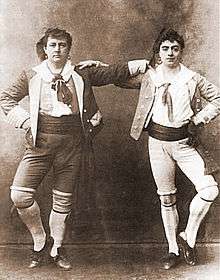
On 12 March, Sullivan responded, "I have lost the liking for writing comic opera, and entertain very grave doubts as to my power of doing it.... You say that in a serious opera, you must more or less sacrifice yourself. I say that this is just what I have been doing in all our joint pieces, and, what is more, must continue to do in comic opera to make it successful."[2]
A series of increasingly acrimonious letters followed over the ensuing weeks, with Sullivan laying down new terms for the collaboration, and Gilbert insisting that he had always bent over backwards to comply with the composer's musical requirements. Gilbert tried to encourage his collaborator:
You say that our operas are Gilbert's pieces with music added by you.... I say that when you deliberately assert that for 12 years you, incomparably the greatest English musician of the age — a man whose genius is a proverb wherever the English tongue is spoken — a man who can deal en prince with operatic managers, singers, music publishers and musical societies — when you, who hold this unparalleled position, deliberately state that you have submitted silently and uncomplainingly for 12 years to be extinguished, ignored, set aside, rebuffed, and generally effaced by your librettist, you grievously reflect, not upon him, but upon yourself and the noble art of which you are so eminent a professor.[3]
Gilbert offered a compromise that Sullivan ultimately accepted — that the composer would write a light opera for the Savoy, and a grand opera (Ivanhoe) for a new theatre that Carte was constructing for that purpose. Sullivan's acceptance came with the proviso that "we are thoroughly agreed upon the subject." Gilbert suggested an opera based on a theatrical company, which Sullivan rejected (though a version of it would be resurrected in 1896 as The Grand Duke), but he accepted an idea "connected with Venice and Venetian life, and this seemed to me to hold out great chances of bright colour and taking music. Can you not develop this with something we can both go into with warmth and enthusiasm and thus give me a subject in which (like The Mikado and Patience) we can both be interested....?"[4]
Gilbert set to work on the new libretto by the early summer of 1889, and by the mid-summer Sullivan had started composing Act I. Gilbert provided Sullivan with alternative lyrics for many passages, allowing the composer to choose which ones he preferred. The long opening number (more than fifteen minutes of continuous music) was the librettist's idea, and it gave Sullivan the opportunity to establish the mood of the work through music. The costumes were designed by Percy Anderson[5] and sets were by Hawes Craven,[6] with choreography by Willie Warde.[7]

They worked all summer and autumn, with a successful opening on 7 December 1889. Press accounts were almost entirely favourable, and the opera enjoyed a run longer than any of their other joint works except for H.M.S. Pinafore, Patience and The Mikado. Sullivan's old collaborator on Cox and Box (and the editor of Punch), F. C. Burnand, wrote, "Magnificento! ... I envy you and W.S.G. being able to place a piece like this on the stage in so complete a fashion."[8]
Reaction of the press and public
Leslie Baily notes, "The bubbling, champagne-quality of the libretto brought out the gayest Sullivan, and the Italian setting called up a warm, southern response from his own ancestry. The Graphic (14 December 1889) pointed out that the music contains not only an English idiom but 'the composer has borrowed from France the stately gavotte, from Spain the Andalusian cachucha, from Italy the saltarello and the tarantella, and from Venice itself the Venetian barcarolle'."[9]
Of Gilbert's contribution, the Illustrated London News reported, "Mr. W. S. Gilbert has returned to the Gilbert of the past, and everyone is delighted. He is himself again. The Gilbert of The Bab Ballads, the Gilbert of whimsical conceit, inoffensive cynicism, subtle satire, and playful paradox; the Gilbert who invented a school of his own, who in it was schoolmaster and pupil, who has never taught anybody but himself, and is never likely to have any imitator—this is the Gilbert the public want to see, and this is the Gilbert who on Saturday night was cheered till the audience was weary of cheering any more."[8]
There was a command performance of The Gondoliers for Queen Victoria and the royal family at Windsor Castle on 6 March 1891, the first performance of a Gilbert and Sullivan opera to be so honoured and the first theatrical entertainment to take place at Windsor since the death of Prince Albert thirty years earlier.[10]
The Carpet Quarrel
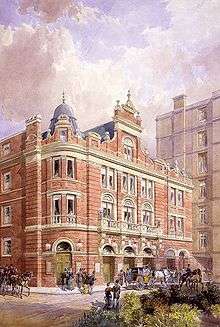
With the exception of their first opera, Richard D'Oyly Carte produced every Gilbert and Sullivan opera and had built the Savoy Theatre specifically for productions of their shows. However, on several occasions during the 1880s the relationship among Gilbert, Sullivan and Carte had been strained.[11]
In April 1890, during the run of The Gondoliers, Gilbert discovered that maintenance expenses for the theatre, including a new £500 (equivalent to £55,433 in 2019) carpet for the front lobby of the theatre, were being charged to the partnership instead of borne by Carte.[11] Gilbert confronted Carte, but the producer refused to reconsider the accounts. Gilbert stormed out and wrote to Sullivan that "I left him with the remark that it was a mistake to kick down the ladder by which he had risen".[11] Helen D'Oyly Carte wrote that Gilbert had addressed Carte "in a way that I should not have thought you would have used to an offending menial."[12] As scholar Andrew Crowther has explained:
After all, the carpet was only one of a number of disputed items, and the real issue lay not in the mere money value of these things, but in whether Carte could be trusted with the financial affairs of Gilbert and Sullivan. Gilbert contended that Carte had at best made a series of serious blunders in the accounts, and at worst deliberately attempted to swindle the others. It is not easy to settle the rights and wrongs of the issue at this distance, but it does seem fairly clear that there was something very wrong with the accounts at this time. Gilbert wrote to Sullivan on 28 May 1891, a year after the end of the "Quarrel", that Carte had admitted "an unintentional overcharge of nearly £1,000 in the electric lighting accounts alone."[11]
Sullivan supported Carte, and Gilbert felt betrayed. Sullivan felt that Gilbert was questioning his good faith, and in any event, Sullivan had other reasons to stay in Carte's good graces: Carte was building a new theatre, the Royal English Opera House, to produce Sullivan's only grand opera, Ivanhoe.[11][13] On 5 May 1890, Gilbert had written to Sullivan: "The time for putting an end to our collaboration has at last arrived."[11] Gilbert brought suit, and after The Gondoliers closed in 1891, he withdrew the performance rights to his libretti and vowed to write no more operas for the Savoy.[14]
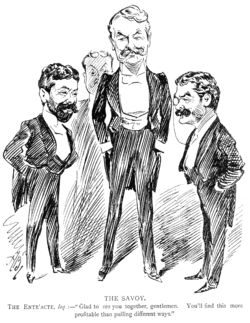
Gilbert's aggressive, though successful, legal action had embittered Sullivan and Carte. But the partnership had been so profitable that Carte eventually sought to reunite the dramatist and composer.[14] After many failed attempts by Carte and his wife, Gilbert and Sullivan reunited through the efforts of Tom Chappell, who published the sheet music to their operas.[15] In 1893, they produced their penultimate collaboration, Utopia, Limited. But The Gondoliers would prove to be Gilbert and Sullivan's last big hit. Utopia was only a modest success, and their final collaboration, The Grand Duke, in 1896, was a failure. The two would never collaborate again.
Roles
- The Duke of Plaza-Toro, A Grandee of Spain (comic baritone)
- Luiz, his Attendant (lyric baritone or tenor)
- Don Alhambra del Bolero, the Grand Inquisitor (bass-baritone)
- Marco Palmieri, Venetian Gondolier (tenor)
- Giuseppe Palmieri, Venetian Gondolier (baritone)
- Antonio, Venetian Gondolier (baritone)
- Francesco, Venetian Gondolier (tenor)
- Giorgio, Venetian Gondolier (bass)
- Annibale, Venetian Gondolier (speaking role/chorus)
- The Duchess of Plaza-Toro (contralto)
- Casilda, her Daughter (soprano)
- Gianetta, Contadina (soprano)
- Tessa, Contadina (mezzo-soprano)
- Fiametta, Contadina (soprano)
- Vittoria, Contadina (mezzo-soprano)
- Giulia, Contadina (mezzo-soprano or soprano)
- Inez, the King's Foster-mother (contralto)
- Chorus of Gondoliers and Contadine, Men-at-Arms, Heralds and Pages
Synopsis
Act I
The scene opens in Venice with 24 farm girls declaring their passionate love for a pair of gondoliers, Marco and Giuseppe Palmieri. These two gondoliers are so gallant and peerless in their manly beauty that the maidens are waiting for them to select brides before they can consider other suitors. A large group of merry gondoliers enter, saying that they adore the girls, but the ladies explain that the two brothers must choose first. When the Palmieri brothers enter, the ladies present them with flowers. The two gondoliers amiably offer to pick their brides in a game of blind man's buff. They appear to be cheating by peeking out from under their blindfolds, however. Eventually, from the crowd of maidens, Giuseppe picks Tessa, and Marco picks Gianetta – "Just the very girl I wanted!" (although the two then politely offer to switch girls). All leave to go to church for the double wedding.
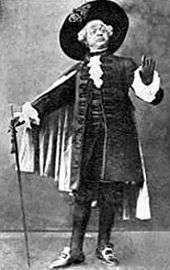
His Grace the Duke of Plaza Toro (Count Matadoro, Baron Picadoro), Her Grace the Duchess, their beautiful daughter Casilda, and their drummer, Luiz, now arrive in Venice from Spain. They have come to meet Don Alhambra del Bolero, the Grand Inquisitor of Spain. As Luiz goes to announce the Duke's presence, the Duke and Duchess tell their daughter a secret that they have kept for twenty years – when she was only six months old, she was married to the infant son and heir of the King of Barataria.[16] She is indignant, since the union was conducted without her consent. The infant prince was taken from his home by the Grand Inquisitor, after the king of Barataria became a Wesleyan Methodist "of the most bigoted and persecuting type", and taken to Venice. The King of Barataria was recently killed in an insurrection, and the hidden prince is now king. As the wife of the new king, Casilda is now the reigning queen of Barataria, and her parents have brought her to meet with the Grand Inquisitor to be introduced to her husband. We soon discover, however that Casilda is secretly in love with Luiz. Left alone together, she tells him of her infant marriage, and they resign themselves to a life forever apart, with only their happy memories to comfort them.
When the Grand Inquisitor arrives, he explains that the prince was raised incognito by Baptisto Palmieri, a humble gondolier, who had a young son of his own about the same age. The gondolier was a drunkard and eventually forgot which boy was his own son and which boy was the prince of Barataria. The two boys (Marco and Giuseppe) grew up and now are both gondoliers themselves. Fortunately, the nurse who took care of the infant prince (and who happens to be Luiz's mother), is now living in the mountains, married to "a highly respectable brigand". Don Alhambra says that he has located her and that she will be able to reveal which of the two gondoliers is the lost prince. If not, he says, "then the persuasive influence of the torture chamber will jog her memory."
In the next scene, the two gondoliers have married Tessa and Gianetta, and as they are extolling the virtues of marriage, Don Alhambra arrives and informs them that one of them is the King of Barataria, but no one knows which. Despite being Republicans, the gondoliers and their new wives are delighted, and agree to go to Barataria at once, acting as one individual until the actual king is identified. The Grand Inquisitor tells them, however, that ladies are not admitted until the actual king is identified, and then each couple can be reunited. The Grand Inquisitor neglects to mention that the King is married to Casilda, fearing that it would cause the men to refuse to leave their new wives. As the two wives are imagining what it will be like to be a queen, their friends enter, and Marco and Giuseppe announce their discovery and promise to reign in a Republican fashion. They announce that in their kingdom, "All shall equal be" and will create new posts such as "the Lord High Coachman on the Box, the Lord High Vagabond in the Stocks". All the men then set sail for Barataria, leaving their wives behind in Venice.
Act II
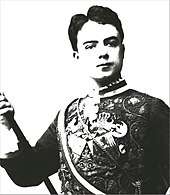
In Barataria, the gondolier-courtiers are all enjoying living under "a monarchy that's tempered with Republican equality". Marco and Giuseppe have been doing all the work around the palace for the past three months - it is the privilege of royalty! They are happy enough with this arrangement, except that they are worried about having to share a single portion of rations between the two of them, and they miss their wives. Soon, however, all the ladies arrive, having risked the long sea voyage from Venice – they could no longer stand the separation. In delight, the reunited couples have a magnificent banquet and a dance (a cachucha).
The Grand Inquisitor arrives at the ball to find that the Republican gondoliers have promoted everyone to the nobility. He explains that there must be a distinction between commoners and those of rank, warning that "when everyone is somebody, then no-one's anybody". He then breaks the news that one of the gondoliers had married Casilda when a baby and therefore is an unintentional bigamist. The gondoliers attempt to console their wives, who are distraught to discover that neither one will be queen, and that one married someone who is already married.
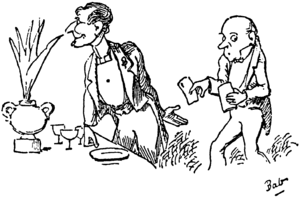
The Duke and Duchess of Plaza Toro soon arrive with the beautiful Casilda. They are now dressed in style, and the Duke explains how he was applied for by the public under the Limited Liability Company Act, and how they now earn a very good living. Appalled, however, at the lack of pomp and ceremony with which they were received, he attempts to educate the two monarchs in proper royal behaviour. After a lesson in etiquette, the two Palmieri brothers are left alone with Casilda. She agrees to be an obedient wife, but warns them that she is "over head and ears in love with someone else." Seizing this opportunity, the two men introduce their wives. The three ladies and two men sing a quintet about their unprecedented predicament.
Don Alhambra brings in the nurse who had tended the infant prince of Barataria twenty years ago. She reveals that when the Grand Inquisitor came to steal the prince, she had loyally hidden him away, and given Don Alhambra her own young son instead. Thus, the king is neither Marco nor Giuseppe, but her own son, Luiz. This resolves the romantic entanglements to everyone's satisfaction. Casilda finds that she is already married to the man she loves, Luiz. The two gondoliers surrender their crown to Luiz and, though a bit disappointed that neither will be a king, they can return happily to Venice with their wives. There is a final dance for the full company, reprising the gondoliers' Act I duet and the cachucha.
Musical numbers
- Overture
- Act I
- 1. "List and learn" (Gondoliers, Antonio, Marco, Giuseppe, and Chorus of Contadine)
- 2. "From the sunny Spanish shore" (Duke, Duchess, Casilda, and Luiz)
- 3. "In enterprise of martial kind" (Duke with Duchess, Casilda, and Luiz)
- 4. "O rapture, when alone together" (Casilda and Luiz)
- 5. "There was a time" (Casilda and Luiz)
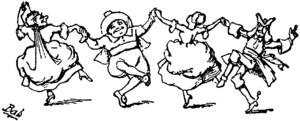
- 6. "I stole the prince" (Don Alhambra with Duke, Duchess, Casilda, and Luiz)
- 7. "But, bless my heart" (Casilda and Don Alhambra)
- 8. "Try we life-long" (Duke, Duchess, Casilda, Luiz, and Don Alhambra)
- 9. "Bridegroom and bride" (Chorus)
- 9a. "When a merry maiden marries" (Tessa)
- 10. "Kind sir, you cannot have the heart" (Gianetta)
- 10a. "Then one of us will be a Queen" (Marco, Giuseppe, Gianetta, and Tessa)
- Act II
- 11. "Of happiness the very pith" (Marco, Giuseppe, and Chorus of Men)
- 12. "Rising early in the morning" (Giuseppe with Chorus)
- 13. "Take a pair of sparkling eyes" (Marco)
- 14. "Here we are at the risk of our lives" (Giuseppe, Tessa, Gianetta, Marco, and Chorus)
- 15. "Dance a cachucha" (Chorus and Dance)
- 16. "There lived a king" (Don Alhambra with Marco and Giuseppe)
- 17. "In a contemplative fashion" (Marco, Giuseppe, Gianetta, and Tessa)
- 18. "With ducal pomp" (Chorus of Men with Duke and Duchess)
- 19. "On the day when I was wedded" (Duchess)
- 20. "To help unhappy commoners" (Duke and Duchess)
- 21. "I am a courtier grave and serious" (Duke, Duchess, Casilda, Marco, and Giuseppe)
- 22. "Here is a case unprecedented" (Marco, Giuseppe, Casilda, Gianetta, Tessa, and Chorus)
Productions
The Gondoliers was immediately a hit in London, playing for 554 performances, the fourth longest of the series (after The Mikado, H.M.S. Pinafore and Patience). It earned more money than any other Savoy opera in its original run. 20,000 copies of the published score were sold on publication, and over 70,000 copies of various arrangements were sold within a few days.[17] D'Oyly Carte's "E" Company mounted the first provincial production on 19 February 1890 in Preston.[18] From then on, it was never absent from the touring repertory until it was omitted from the final two seasons (September 1980–February 1982) before the closing of the D'Oyly Carte Opera Company. Percy Anderson refreshed his original costume designs in 1917, 1919 and 1928.[6]
The opera fared less well in New York. It opened at the New Park Theatre on 7 January 1890 and was immediately panned. Gilbert "refused to indorse [sic] the company sent to New York ... because he considered the company a 'scratch' one."[19] Carte came to New York to investigate and closed the production on 13 February. He brought in replacements for most of the cast, and remounted the production at Palmer's Theatre on 18 February.[20] However, the damage was done, and the production ran for just 103 performances in total. The New York press dubbed the opera "the gone-dollars."[21] The first production on the European continent was given at the Theater an der Wien, Vienna (as Die Gondoliere) on 20 September 1890.[22] In Australia, its first authorised performance was on 25 October 1890 at the Princess Theatre, Melbourne, produced by J. C. Williamson.
A new production, with new sets and costumes designed by Charles Ricketts, was prepared for the opening of the renovated Savoy Theatre on 21 October 1929.[6] The critic Ernest Newman wrote: "It was a subtle stroke to open with The Gondoliers; there is a peculiar richness of blood in the music of this work that makes the new theatre and the new designs and dresses by Mr. Charles Ricketts particularly appropriate." The performance was conducted by Malcolm Sargent, and the theatre's only box was occupied by Lady Gilbert.[23] Peter Goffin designed new touring sets in 1957,[6] and another notable new production was staged by the company in 1958 at the Princes Theatre with sets and costumes by Goffin.[6][24] In 1967, new costumes were designed by Luciana Arrighi, with new sets by John Stoddart.[25]
The first non-D'Oyly Carte professional production in the United Kingdom was given by Scottish Opera on 12 December 1968, with Ian Wallace as the Duke.[26] There was also a production by the New Sadler's Wells Opera in February 1984, with John Fryatt as the Duke and Donald Adams as Don Alhambra.[26] A Mafia-themed adaptation of the opera, by John Doyle and Sarah Travis, was given at the Watermill Theatre and transferred to the Apollo Theatre in the West End in 2001. The production utilised Doyle's signature conceit of the actors playing their own orchestra instruments.[27]
The following table shows the history of the D'Oyly Carte productions in London and New York during Gilbert's lifetime:
| Theatre | Opening Date | Closing Date | Perfs. | Details |
|---|---|---|---|---|
| Savoy Theatre | 7 December 1889 | 20 June 1891 | 554 | First London run. |
| New Park Theatre, New York | 7 January 1890 | 13 February 1890 | 103 | Authorised American production. |
| Palmer's Theatre, New York | 18 February 1890 | 19 April 1890 | ||
| Savoy Theatre | 22 March 1898 | 21 May 1898 | 62 | First London Revival; interrupted for the production of The Beauty Stone from 28 May – 16 July 1898. |
| 17 July 1898 | 17 September 1898 | 63 | ||
| Savoy Theatre | 22 January 1907 | 24 August 1907 | 75 | First Savoy repertory season; played with three other operas (closing date shown is of the entire season). |
| Savoy Theatre | 18 January 1909 | 27 March 1909 | 22 | Second Savoy repertory season; played with five other operas (closing date shown is of the entire season). |
Historical casting
The following tables show the casts of the principal early productions and D'Oyly Carte Opera Company touring repertory at various times through to the company's 1982 closure. The roles of Ottavio and the Drummer Boy were credited only in the original production. Notable casting substitutions are shown for the first New York production; otherwise, only first-night casts are shown.
| Role | Savoy Theatre 1889[28] | New Park Theatre 1890[20][29] | Savoy Theatre 1898[30] | Savoy Theatre 1907[31] | Savoy Theatre 1909[32] |
|---|---|---|---|---|---|
| Duke | Frank Wyatt | George Temple | William Elton | Charles H. Workman | Charles H. Workman |
| Luiz | Wallace Brownlow | Arthur Marcel | Jones Hewson | Alec Johnstone | Leo Sheffield |
| Don Alhambra | W. H. Denny | John A. Muir[33] | Walter Passmore | John Clulow | Rutland Barrington |
| Marco | Courtice Pounds | Richard Clarke | Charles Kenningham | Pacie Ripple | Henry Herbert |
| Giuseppe | Rutland Barrington | Duncan Barrington[34] | Henry Lytton | Richard Green | Henry Lytton |
| Antonio | A. Medcalf | Helier Le Maistre | Leonard Russell | Overton Moyle | Fred Hewett |
| Francesco | Charles Rose | Mr. McCarthy | Cory James | Henry Burnand | Ernest Leeman |
| Giorgio | George de Pledge | Alec Lee | H. G. Gordon | Tom Redmond | Cecil Curtis |
| Annibale | J. Wilbraham | Percy Charles | Charles Childerstone | Leo Sheffield | A. Laurence Legge |
| Ottavio | Charles Gilbert | role eliminated | |||
| Drummer Boy | Arthur Mansfield | role eliminated | |||
| Duchess | Rosina Brandram | Kate Talby | Rosina Brandram | Louie René | Louie René |
| Casilda | Decima Moore | Agnes McFarland | Ruth Vincent | Marie Wilson | Dorothy Court |
| Gianetta | Geraldine Ulmar | Esther Palliser/Nita Carritte[35] | Emmie Owen | Lilian Coomber | Elsie Spain |
| Tessa | Jessie Bond | Mary Duggan | Louie Henri | Jessie Rose | Jessie Rose |
| Fiametta | Nellie Lawrence | A. Watts | Ethel Jackson | Violette Londa | Ethel Lewis |
| Vittoria | Annie Cole | Miss Sadger | Jessie Rose | Norah McLeod | Beatrice Boarer |
| Giulia | Norah Phyllis | Grace Pyne | Madge Moyse | Clara Dow | Adrienne Andean |
| Inez | Annie Bernard | Marie Rochfort | Jessie Pounds | Ethel Morrison | Amy Royston |
| Role | D'Oyly Carte 1920 Tour[36] | D'Oyly Carte 1930 Tour[37] | D'Oyly Carte 1939 Tour[38] | D'Oyly Carte 1945 Tour[39] | D'Oyly Carte 1951 Tour[40] |
| Duke | Henry Lytton | Henry Lytton | Martyn Green | Grahame Clifford | Martyn Green |
| Luiz | Sydney Granville | John Dean | Richard Dunn | Herbert Garry | Henry Goodier |
| Don Alhambra | Leo Sheffield | Sydney Granville | Sydney Granville | Richard Walker | Richard Watson |
| Marco | Derek Oldham | Charles Goulding | John Dudley | John Dean | Leonard Osborn |
| Giuseppe | Frederick Hobbs | Leslie Rands | Leslie Rands | Leslie Rands | Alan Styler |
| Antonio | Harry Arnold | Richard Walker | Richard Walker | Wynn Dyson | Peter Pratt |
| Francesco | J. W. Turnbull | Herbert Aitken | Leonard Osborn | C. William Morgan | Thomas Hancock |
| Giorgio | Allen Morris | L. Radley Flynn | L. Radley Flynn | L. Radley Flynn | L. Radley Flynn |
| Annibale | Hugh Enes Blackmore | T. Penry Hughes | T. Penry Hughes | Hilton Layland | Stanley Youngman |
| Duchess | Bertha Lewis | Bertha Lewis | Evelyn Gardiner | Ella Halman | Ella Halman |
| Casilda | Sylvia Cecil | Winifred Lawson | Margery Abbott | Margery Abbott | Margaret Mitchell |
| Gianetta | Elsie Griffin | Sylvia Cecil | Helen Roberts | Helen Roberts | Muriel Harding |
| Tessa | Nellie Briercliffe | Nellie Briercliffe | Marjorie Eyre | Marjorie Eyre | Joan Gillingham |
| Fiametta | Elsie Chantler | Sybil Gordon | Marjorie Flinn | Ann Nicholson | Enid Walsh |
| Vittoria | Winifred Downing | Beatrice Elburn | Ivy Sanders | Ivy Sanders | Ceinwen Jones |
| Giulia | Winifred Williamson | Murielle Barron | Maysie Dean | Laura Crombie | Joyce Wright |
| Inez | Anna Bethell | Marguerite Hylder | Ella Halman | Caryl Fane | Caryl Fane |
| Role | D'Oyly Carte 1959 Tour[41] | D'Oyly Carte 1968 Tour[42] | D'Oyly Carte 1975 Tour[43] | D'Oyly Carte 1980 Tour[44] | |
| Duke | Peter Pratt | John Reed | John Reed | James Conroy-Ward | |
| Luiz | John Fryatt | Philip Potter | Colin Wright | Harold Sharples | |
| Don Alhambra | Kenneth Sandford | Kenneth Sandford | Kenneth Sandford | Kenneth Sandford | |
| Marco | Thomas Round | Ralph Mason | Meston Reid | Meston Reid | |
| Giuseppe | Alan Styler | Thomas Lawlor | Michael Rayner | Peter Lyon | |
| Antonio | John Reed | Howard Williamson | James Conroy-Ward | Alan Spencer | |
| Francesco | Frederick Sinden | David Young | Jeffrey Cresswell | Barry Clark | |
| Giorgio | George Cook | George Cook | John Broad | Michael Buchan | |
| Annibale | John Reed | Howard Williamson | James Conroy-Ward | Alistair Donkin | |
| Duchess | Ann Drummond-Grant | Christene Palmer | Lyndsie Holland | Patricia Leonard | |
| Casilda | Jennifer Toye | Valerie Masterson | Julia Goss | Evette Davis | |
| Gianetta | Jean Hindmarsh | Susan Jackson | Pamela Field | Barbara Lilley | |
| Tessa | Joyce Wright | Pauline Wales | Judi Merri | Lorraine Daniels | |
| Fiametta | Mary Sansom | Anne Sessions | Marjorie Williams | Suzanne O'Keeffe | |
| Vittoria | Ceinwen Jones | Marian Martin | Patricia Leonard | Helene Witcombe | |
| Giulia | Anne Sessions | Julia Goss | Anne Egglestone | Jane Stanford | |
| Inez | Beti Lloyd-Jones | Beti Lloyd-Jones | Beti Lloyd-Jones | Jill Pert | |
Recordings
The 1927 Gondoliers is admired for its excellent cast. The 1961 D'Oyly Carte recording is a good stereo recording and includes complete dialogue. The 1957 Sargent/Glyndebourne and 1991 New D'Oyly Carte recordings are both musically well regarded.[45]
More recent professional productions have been recorded on video by the International Gilbert and Sullivan Festival.[46]
- Selected recordings
- 1927 D'Oyly Carte – Conductor: Harry Norris[47]
- 1950 D'Oyly Carte – New Promenade Orchestra, Conductor: Isidore Godfrey[48]
- 1957 Sargent/Glyndebourne – Pro Arte Orchestra, Glyndebourne Festival Chorus, Conductor: Sir Malcolm Sargent[49]
- 1961 D'Oyly Carte (with dialogue) – New Symphony Orchestra of London, Conductor: Isidore Godfrey[50]
- 1972 G&S For All (video; abridged) – G&S Festival Chorus & Orchestra, Conductor: Peter Murray[51]
- 1977 D'Oyly Carte (with dialogue) – Royal Philharmonic Orchestra, Conductor: Royston Nash[52]
- 1982 Brent Walker Productions (video) – Ambrosian Opera Chorus, London Symphony Orchestra, Conductor: Alexander Faris; Stage Director: Peter Wood[53]
- 1991 New D'Oyly Carte – Conductor: John Pryce-Jones[54]
Notes
- Jacobs, p. 287
- Jacobs, p. 288
- Jacobs, p. 291
- Jacobs, p. 294
- "A Tonic to the Imagination" (Anderson's costume designs on display at the Harry Ransom Center collection), The University of Texas at Austin, accessed 26 May 2012
- Rollins and Witts, Appendix, p. VIII
- Savoy Theatre programme, The Gondoliers, 7 December 1889. The playbill states: "The dances arranged by Mr Warde (by permission of M. Marius)". At that time, Warde was appearing at the Avenue Theatre under contract to Marius. See The Era, 14 December 1889, p. 8.
- Baily, p. 344
- Baily, p. 342
- Baker, Anne Pimlott. "Moore, (Lilian) Decima (1871–1964)", Oxford Dictionary of National Biography, Oxford University Press, September 2004, accessed 12 February 2009
- Crowther, Andrew (28 June 1997). "The Carpet Quarrel Explained". The Gilbert and Sullivan Archive. Archived from the original on 6 October 2014. Retrieved 6 November 2007.
- Stedman, p. 270
- Ainger, pp. 312–316
- Shepherd, Marc. "Introduction: Historical Context", The Grand Duke, p. vii, New York: Oakapple Press, 2009. Linked at "The Grand Duke", Archived 20 June 2009 at the Wayback Machine The Gilbert and Sullivan Archive, accessed 7 July 2009.
- Wolfson, John (1976). Final curtain: The last Gilbert and Sullivan Operas. London: Chappell in association with A. Deutsch. ISBN 0-903443-12-0, p. 7
- In Don Quixote, Sancho becomes the governor of an island called Barataria
- Dark and Grey, p. 115
- Rollins and Witts, p. 75
- "Are Gilbert and Sullivan Out?" (PDF). The New York Times. 14 January 1890. Retrieved 8 September 2007.
- Prestige, Colin. "D'Oyly Carte and the Pirates", a paper presented at the International Conference of G&S held at the University of Kansas, May 1970, p. 147.
- Baily, p. 347.
- Gänzl, p. 384
- Programme with photos of the new theatre and productions
- "New Scenery and Costumes" for The Gondoliers 1958, The Sphere, 27 December 1958, reprinted at The Gilbert and Sullivan Archive (2008)
- "Victorian look for Gondoliers", The Times, 4 December 1967, p. 9
- Gänzl, p. 385
- The Gondoliers Archived 17 September 2010 at the Wayback Machine. Albemarle of London, 2009, accessed 14 August 2010
- Rollins and Witts, p. 12
- Gänzl, p. 384; the cast at Palmer's theatre was as follows: Duke: Frank David; Luiz: Helier Le Maistre; Don Alhambra: Fred Billington; Marco: Richard Clarke; Giuseppe: Richard Temple; Antonio: O. J. Rowlands; Francesco: Mr. Boole; Giorgio: Albert Kavanagh; Annibale: Percy Charles; Duchess: Kate Talby; Casilda: Norah Phyllis; Gianetta: Esther Palliser; Tessa: Mary Duggan; Fiametta: Mattie Geoffrey; Vittoria: Cora Tinnie; Giulia: A. Watts; Inez: Rose Leighton
- Rollins and Witts, p. 17
- Rollins and Witts, p. 22
- Rollins and Witts, p. 23
- Fred Billington after the transfer to Palmer's Theatre.
- Brother of Rutland Barrington. Gänzl (p. 384) has Rutland Barrington, which cannot be correct, as Rutland was playing Giuseppe in London. Richard Temple took over at Palmer's Theatre
- On 5th Jan 1891 Nita Carritte started to play the role of Gianetta, giving around 54 performances, until 27th February. (See www.c20th.com archive)
- Rollins and Witts, p. 136
- Rollins and Witts, p. 154
- Rollins & Witts, p. 163
- Rollins and Witts, p. 169
- Rollins and Witts, p. 175
- Rollins and Witts, p. 183
- Rollins and Witts, 2nd supplement, p. 15
- Rollins and Witts, 3rd supplement, p. 28
- Rollins and Witts, 4th supplement, p. 40
- Shepherd, Marc. "Recordings of The Gondoliers", The Gilbert & Sullivan Discography, 24 June 2009, accessed 30 July 2016
- "Products" Archived 26 June 2012 at the Wayback Machine, Musical Collectibles, 30 July 2016
- Shepherd, Marc. "The 1927 D'Oyly Carte Gondoliers", The Gilbert & Sullivan Discography, 28 November 2010, accessed 30 July 2016
- Shepherd, Marc. "The 1950 D'Oyly Carte Gondoliers", The Gilbert & Sullivan Discography, 11 July 2009, accessed 30 July 2016
- Shepherd, Marc. "The Sargent/EMI Gondoliers (1957)", The Gilbert & Sullivan Discography, 12 July 2009, accessed 30 July 2016
- Shepherd, Marc. "The 1961 D'Oyly Carte Gondoliers", The Gilbert & Sullivan Discography, 12 September 2008, accessed 30 July 2016
- Shepherd, Marc. "The G&S For All Gondoliers (1972)", The Gilbert & Sullivan Discography, 6 April 2009, accessed 30 July 2016
- Shepherd, Marc. "The 1977 D'Oyly Carte Gondoliers", The Gilbert & Sullivan Discography, 23 July 2005, accessed 30 July 2016
- Shepherd, Marc. "The Brent Walker Gondoliers (1982)", The Gilbert & Sullivan Discography, 5 April 2009, accessed 30 July 2016
- Shepherd, Marc. "The New D'Oyly Carte Gondoliers (1991)", The Gilbert & Sullivan Discography, 25 November 2001, accessed 30 July 2016
References
- Baily, Leslie (1967). The Gilbert & Sullivan Book. London: Spring Books. Second edition, second impression.
- Bradley, Ian (ed.) (1952). The Annotated Gilbert and Sullivan, Vol. 1. Harmondsworth, Middlesex, England: Penguin Books, Ltd.CS1 maint: extra text: authors list (link)
- Dark, Sidney; Rowland Grey (1923). W. S. Gilbert: His Life and Letters. London: Methuen & Co. Ltd.
- Gänzl, Kurt (1986). The British Musical Theatre—Volume I, 1865–1914. Oxford: Oxford University Press.
- Green, Martyn (ed.) (1961). Martyn Green's Treasury of Gilbert & Sullivan. New York: Simon and Schuster, Inc. ISBN 0-671-22419-0.CS1 maint: extra text: authors list (link)
- Jacobs, Arthur (1992). Arthur Sullivan – A Victorian Musician (Second ed.). Portland, OR: Amadeus Press.
- Prestige, Colin (1971). "D'Oyly Carte and the Pirates: The Original New York Productions of Gilbert and Sullivan" (PDF). In James Helyar, ed. (ed.). Gilbert and Sullivan Papers Presented at the International Conference Held at the University of Kansas in May 1970. Lawrence, Kansas: University of Kansas Libraries. pp. 113–48.
- Rollins, Cyril; R. John Witts (1962). The D'Oyly Carte Opera Company in Gilbert and Sullivan Operas: A Record of Productions, 1875–1961. Michael Joseph. OCLC 504581419.
- Rollins, Cyril; R. John Witts. The D'Oyly Carte Opera company in Gilbert and Sullivan Operas, Second Supplement 1966–1971; Third Supplement 1971–1976; and Fourth Supplement 1976–1982. Privately printed.
External links
| Wikimedia Commons has media related to The Gondoliers. |
| Wikisource has original text related to this article: |
- The Gondoliers at The Gilbert & Sullivan Archive
- The Gondoliers at The Gilbert & Sullivan Discography
- Gilbert & Sullivan song parodies, including some from The Gondoliers
- List of longest-running theatre pieces in London and New York
- Biographies of the people listed in the historical casting chart
- Programme from the original run
- Photo of British prisoners performing The Gondoliers in Germany in 1917
.jpg)